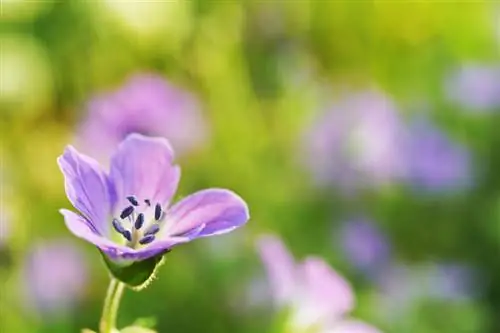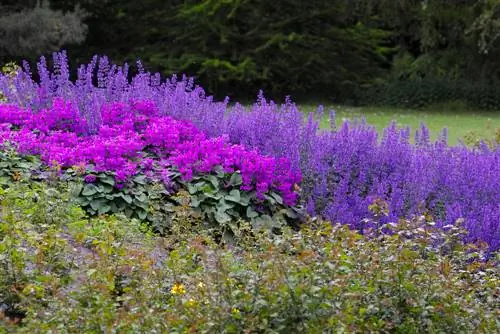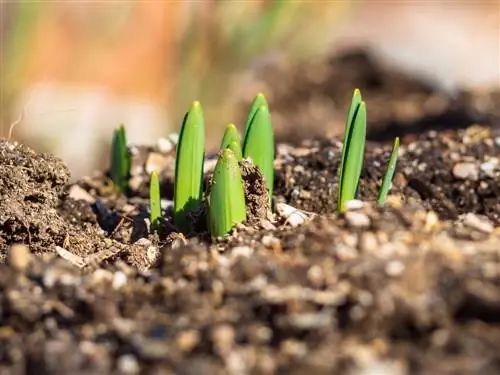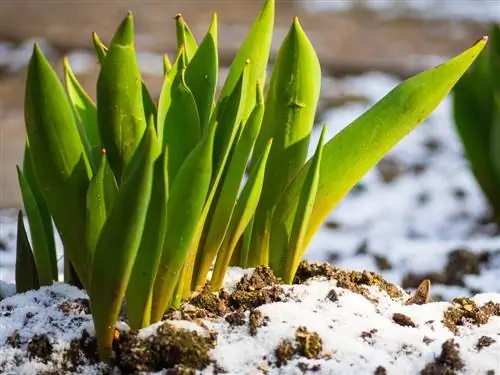- Author admin [email protected].
- Public 2023-12-25 17:45.
- Last modified 2025-06-01 06:02.
Magnificent bedding perennial, lush container plant, undemanding rock garden flower, compact ground cover - cranesbill has many faces that bring us joy in the hobby garden. Get an overview of how geranium cultivation is successful here. Open questions about the International Perennial of the Year will be answered here.
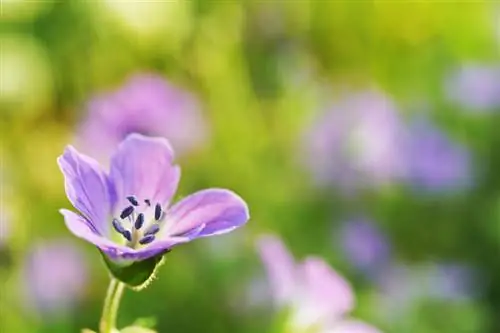
How do I properly care for cranesbills (geraniums)?
Storksbill (Geranium) is a versatile, hardy perennial with a flowering period from May to September. The plant prefers nutrient-rich, humus-rich and well-drained soil. Care includes regular watering, fertilization from April to August, and pruning in spring.
Planting cranesbills correctly
Good soil preparation is the be-all and end-all when planting geraniums. Remove weeds, roots and stones so that the perennials find fine, crumbly soil that is deeply loosened. During this time, the still potted root ball is in a bucket of water. Follow these steps:
- The planting pit has twice the volume of the root ball
- Optimize the excavated soil with compost, horn shavings and, if necessary, some sand
- Plant the potted geranium, press the soil and water
Spread a layer of mulch suitable for the location, such as leaves, bark mulch or gravel. To ensure that a cranesbill grows well, water regularly afterwards. If you plant the perennial in the bucket or balcony box, the process is similar. In addition, spread some pottery shards over the water drain as drainage to prevent waterlogging.read more
Care tips
Despite all the species-specific subtleties, geranium care is largely consistent according to the following guidelines:
- Do not allow the root ball to dry out at any time
- If possible, avoid irrigating cranesbills overhead
- Fertilize organically or minerally from April to August
- Cut off wilted flower stems to encourage repeat blooms
- Prune the leaves close to the ground until early spring
The hardy perennial is given a cover of leaves in the bed to protect it from moisture. Wrap planters thickly in foil as the root ball cannot cope with repeated changes from frost to thaw. Water geraniums during cold frost on mild days without warming the water first.read more
Which location is suitable?
The fragile beauty of geranium flowers belies their robust flexibility and site tolerance. In fact, countless species thrive in full sun locations with dry soil conditions, while other cranesbills thrive in partially shaded locations with moist soil. Some particularly vigorous specimens stand out as powerful ground cover plants that suppress annoying weeds with their strong leaves in low-light beds.read more
The correct planting distance
Coordinate the expected growth width and the planting distance. This gives a geranium enough space to develop without creating unwanted gaps in its appearance. The following examples make the rule of thumb more concrete:
- Splendid cranesbill: growth width 30-50 cm - planting distance 30-50 cm
- Grey cranesbill: growth width 10-15 cm - planting distance 10-15 cm
Geraniums that grow compactly are also suitable for cultivation in pots or balcony boxes. In this case, the planting distance may be reduced by 5 cm due to the modified conditions in planters.
What soil does the plant need?
The flexibility of geraniums in terms of lighting conditions continues in terms of soil conditions. There are several cranesbills for almost every location in the garden. The Dalmatian cranesbill (Geranium dalmaticum) is ideal for the rock garden, the magnificent cranesbill (Geranium x magnificum) stands out on the partially shaded edge of the wood, and the native meadow cranesbill (Geranium patrense) can withstand even frosty temperatures in open spaces. The earth should basically have the following properties:
- Nutritional and humic
- Fresh-moist to sandy-loamy
- Well-drained and loose
- Neither very calcareous nor very acidic
In the balcony box or bucket, geraniums thrive in commercially available compost-based potting soil, which you enrich with a handful of sand or lava granules.
What is the best time to plant?
A well-chosen planting time is May and June, before the weather becomes too hot and dry. In addition, autumn from late August to early October is considered a suitable date for planting perennials.
When is flowering time?
The flowering period extends from May to September, depending on the species and variety. Over this long period of time, the cranesbill delights us with its five-petalled flowers, which grow in the shape of a bowl, wheel or plate. The wide spectrum of colors includes every conceivable shade of red, blue and blue as well as pure white.read more
Cut cranesbill correctly
If you cut the geraniums back after the first flowering, the perennials will thank you with beautiful subsequent blooms. In early spring, the dead leaves are removed at the latest to make room for fresh shoots and to prevent fungal infections. On large areas with ground cover geraniums, pruning can often be achieved using a lawnmower set to the maximum cutting height.read more
Water cranesbill
Regulate the water balance, tailored to the cranesbill species and variety planted. The top priority is never to let a geranium dry out or expose it to waterlogging. Preferably water directly to the roots in the early morning or in the evening if the thumb test indicates dried substrate. Irrigating flowers and leaves is always accompanied by the risk of fungal diseases and pest infestation.
Fertilize cranesbill properly
Tail the nutrient supply specifically to the type and variety cultivated. A gray dwarf cranesbill (Geranium cinereum) with a height of 15 cm in a gravel bed requires a lower dose of fertilizer than a majestic cranesbill (Geranium ibericum) with a height of 90 cm in a perennial bed. In general, the following guidelines apply to the correct fertilization of geraniums:
- Start fertilization in spring after pruning
- Fertilize with compost every 2-4 weeks until the end of July/beginning of August
- Administer a solid or liquid long-term fertilizer in spring and summer
The application of fertilizer ends in August so that a cranesbill can prepare for the coming winter.
Diseases
With professional care, you will rarely have to complain about geranium diseases. During warm, humid summer weather, infection by mildew can sometimes occur. If a mealy-white coating spreads on or under the leaves, cut off the affected parts of the plant immediately and dispose of them with household waste. Treat the diseased flower with a solution of 100 ml fresh milk and 900 ml water until symptoms no longer appear.
Wintering
A cranesbill has enough frost hardiness to survive the local winter unscathed. If possible, leave the leaves on the perennial until spring, as the leaves act as natural protection. The following precautions should still be taken in exposed, rough locations and in planters:
- Hill up the root area with leaves, brushwood, straw or compost
- Cover pots and balcony boxes with bubble wrap, felt or jute
- Place containers on cold-insulating material, such as wood or Styrofoam
Cold frost exposes geraniums to drought stress in winter. Therefore, water the perennials in the bed and planter on mild days.
Propagate cranesbills
The suitable propagation method depends on the specific growth behavior of a geranium. The majority of cranesbills can be reproduced excellently by division. How to do it correctly:
- Dig up the entire rhizome in March/April
- Shake off the soil thoroughly
- Tear off short shoots with their own fine roots
- Plant the cracklings in small pots, care for them in a partially shaded location until autumn and plant them
Alternatively, grow young geraniums using cuttings. Cut off he althy, non-flowering shoots in early summer and place them in pots with humus-rich soil. In a partially shaded place, keep the cuttings constantly moist so that they can be planted out after rooting.read more
How do I transplant correctly?
With the exception of a few cranesbill species, which form very long taproots, most geraniums tolerate a change of location without any problems. Choose a mild day in April/May or August/September. The more root volume you dig up, the higher the chances of success. Root strands that are too long are cut with a spade or knife. Plant the perennial in the new location without a long delay by maintaining the previous planting depth. Now it's important to have a sufficient water supply so that the stressed geranium can quickly extend its roots.
Storksbill in a pot
Small cranesbills, such as hardy Geranium himalayense, thrive excellently in pots. Choose a container with an opening at the bottom to spread pottery shards over it as drainage. Add good compost-based potting soil on top and plant the geranium up to the bottom pair of leaves. This is how you care for geraniums in a pot in an exemplary manner:
- Always water when the soil is dry
- From April to July/August, fertilize liquidly every 14 days
- Cut off wilted flower stems after the first bloom
- Before the first frost, wrap the pot with foil or take it to the bright, frost-free winter quarters
Water a cranesbill every now and then during the cold season because the root ball must not dry out. Cut off the remaining leaves in spring at the latest.
What are the differences between geraniums and geraniums?
Although the popular balcony geraniums (pelargoniums) are botanically classified as part of the large plant family of the cranesbill family (Geraniaceae), there is an elementary difference to the cranesbill genus: standing and hanging geraniums for the balcony have no winter hardiness whatsoever. Geranium (storksbill), on the other hand, thrives as a long-lasting, hardy perennial, with deciduous or evergreen leaves depending on the species.
What types of geranium are suitable for the garden?
More than 400 magnificent geranium species worldwide make the hearts of gardeners beat faster. A large number of these perennials thrive outdoors for many years in the Central European climate. The following selection presents outstanding cranesbills:
- Blood-red cranesbill (Geranium sanguineum) - creeping perennial bloomer, wintergreen, extremely robust
- Grey cranesbill (Geranium cinereum) - cushion-forming, purple-white, veined flowers in the rock garden
- Pyrenean cranesbill (Geranium endressii) - suitable as ground cover in open spaces
- Swamp Cranesbill (Geranium palustre) - ideal at the edge of ponds and streams, red flowers from June to September
- Meadow cranesbill (Geranium pratense) - deciduous, blue flowers from June to August, bedding plant
- Rock Cranesbill (Geranium macrorrhizum) - reddish, veined flowers on the semi-shady edge of the wood
- Great cranesbill (Geranium x magnificum) - violet flowers for sunny to semi-shady locations
read more
Beautiful varieties
- Patricia: spectacular perennial with magenta flowers and black eye; Growth height 60-70 cm
- Philippe Vapelle: purple Caucasian cranesbill with suede-like leaves, robust and drought tolerant
- Album: pure white flowering Geranium sanguineum for the rock garden with wonderful foliage color in autumn
- Plenum: light purple floret flowers on the completely hardy Himalayan cranesbill; Growth height 30-40 cm
- Czakor: distinctive on the semi-shady edge of the wood with pink flowers from May to July and evergreen foliage
- Rebecca Moss: hardy ground cover cranesbill with lilac flowers from June to August

